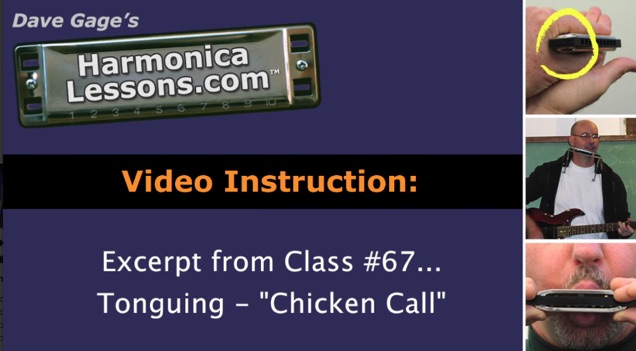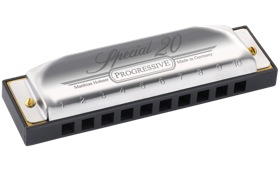"How To Play Harmonica (sound better)"
This article, "How to Play Harmonica (and Sound Better)" is directed at advanced harmonica players that have been playing harmonica for a few years or longer and can't seem to get that 'pro' sound and feel. Beginner harmonica players will also find this information helpful. You will get an insight into what it takes to become a pro level player or just a better player than you are today. If you've got all the necessary riffs and techniques but still feel over shadowed by your fellow harmonica players and the recordings you hear, read on.
"How To Play Harmonica (and Sound Better)"
by Dave Gage

One of the playing tips found in the One Liner Tips section says it perfectly, "All great players have two things in common: good tone (sound) and good timing (rhythm). Their note selections and riffs may vary greatly, but they make whatever it is they play sound good." It's easy to say, and certainly makes sense, but how you can get there is the big question.
The first and most obvious answer would be to do what all the great players from the '50s, '60s, and '70s did; play all the time and do it for twenty or more years. I don't care who you are or what your musical background is, if you play any instrument or do any activity long enough you will get good by default. Guaranteed. The trick is to get where you want to be without waiting 20 or 30 years. Well, the good news is you can cut that time down considerably. The not-so-good news (for some people at least) is that it will still take around 5-10 years to master your chosen harmonica style. Utimately that means, playing and practicing a lot, and getting out and performing regularly, preferably with your own group. If you want to be as good as the pros you need to do what the pros do (even if you don't plan to make a career out of it).
Tiger Woods may have started playing golf at age 3 and had the benefit of parents that did everything they could to help him realize his goals, but that's not what makes him the best golfer in the world. It is his spirit, attitude, focus, and love for the game that drives him to be the best. What exactly is he driven to do? Practice, practice, play, practice, workout, play, practice, win tournaments, practice etc. What does he spend his time working on? Everything, but primarily the basics. He never stops trying to be better than he was the day before.
What does this have to do with you, the harmonica player? Having the love for harmonica and the drive to improve your playing is one thing, but to become as good a player as the greats, you must work on the basics. Natural ability and love for what you're doing will only take you so far. Tiger works on his basics- putting, chipping, iron shots, and driving constantly; no matter how good he is already. For you to become a better harmonica player you need to work on your basics, tone and timing.
Tone
One of the incorrect assumptions a lot of people make is that the "great tone" is solely derived from a specific microphone and amplifier combination or through "studio magic". Mics and amps and effects only amplify what you put into them. The real secret to a great sound is starting with a great acoustic sound (tone) and then adding the amplification and effects later.
The great acoustic sound is primarily created by good breathing technique (Webmaster's Note- check out our Breathing section for more details). To a lesser extent, your great tone may also include the use of hand effects, tonguing, tongue blocking, bending, and dynamics (Webmaster's Note- all these techniques are explained in detail in the Techniques section).
Foremost, work on your breathing. Stay relaxed, push and pull the air from your diaphragm, drop your jaw to open your oral cavity, get the airflow through the harmonica- not just into it, and make use of the hole's entire air chamber when breathing.
It is true that the correct use of breathing can take many years of practice and attentiveness to attain that big, warm, loud, full sound that the pros get. Although it does take time, it is worth the effort to ultimately be able to make every note and riff you play sound better.
Timing
Good timing may take you less time to achieve with focused practice and drills than the breathing, but for many people, it just seems like work. It is worth the time you invest though because great timing means "great feel". Players like James Cotton, Paul Butterfield, Norton Buffalo, Stevie Wonder, Sonny Terry, John Mayall; to name a few, just plain groove. Their playing makes you want to tap your foot or move your body.
The drills required to attain good timing are the same for all instruments. First and foremost, you will want to work on 1/4 note drills before adding 1/2 note, 1/8 note, triplet, and whole note drills. Quarter notes are the basic pulse for most music and is what your foot taps to. A month or two of just 1/4 note practice will make an immense difference in your playing.
Start your 1/4 note drills with a simple blow-draw pattern and work your way up to scales (Webmaster's Note- see our Scales section for notes and tabs). Begin at a medium speed before going faster or slower (by the way, the slower the tempo is, the harder it is to play in time). Try to be a machine and really nail the center of every beat. Avoid coming in early or arriving late on the beat. Because of the fear that they will come in late, the majority of people will tend to "rush", that is, come in early on the beat.
First try the 1/4 note drills with only your foot tap. Don't play along with anything for a week or two. Sync up your foot tap with every note you play. When you have gotten reasonably good at this, you can then try the 1/4 drills while playing to rhythm. Whatever you choose to practice with, make sure it's LOUD, so you can hear and feel the beat. Amplified drum machines, rhythm CDs, and MIDI sequences from your computer are great to practice to. Metronomes are my last choice because they tend to not be loud enough to hear and feel over your own playing.
Dave Gage has been playing diatonic and chromatic harmonica since the late seventies and is the author and founder of Harmonica Lessons.com. Before forming the Dave Gage Band (later called GAGE), he played with numerous cover and original bands doing everything from folk and bluegrass to 60's and 70's rock, funk and Top 40, hard rock and heavy metal, and all of these primarily playing harmonica. His use of the 'tongue-switching' technique to create new sounds and a rock style on the harmonica is unique. The GAGE Band's newest release, "Love You Just The Same" is now available. His first CD release, "Well You Can't, Now Can You", features his classic solo instrumental "Tap". More Dave Gage bio.
The first and most obvious answer would be to do what all the great players from the '50s, '60s, and '70s did; play all the time and do it for twenty or more years. I don't care who you are or what your musical background is, if you play any instrument or do any activity long enough you will get good by default. Guaranteed. The trick is to get where you want to be without waiting 20 or 30 years. Well, the good news is you can cut that time down considerably. The not-so-good news (for some people at least) is that it will still take around 5-10 years to master your chosen harmonica style. Utimately that means, playing and practicing a lot, and getting out and performing regularly, preferably with your own group. If you want to be as good as the pros you need to do what the pros do (even if you don't plan to make a career out of it).
Tiger Woods may have started playing golf at age 3 and had the benefit of parents that did everything they could to help him realize his goals, but that's not what makes him the best golfer in the world. It is his spirit, attitude, focus, and love for the game that drives him to be the best. What exactly is he driven to do? Practice, practice, play, practice, workout, play, practice, win tournaments, practice etc. What does he spend his time working on? Everything, but primarily the basics. He never stops trying to be better than he was the day before.
What does this have to do with you, the harmonica player? Having the love for harmonica and the drive to improve your playing is one thing, but to become as good a player as the greats, you must work on the basics. Natural ability and love for what you're doing will only take you so far. Tiger works on his basics- putting, chipping, iron shots, and driving constantly; no matter how good he is already. For you to become a better harmonica player you need to work on your basics, tone and timing.
Tone
One of the incorrect assumptions a lot of people make is that the "great tone" is solely derived from a specific microphone and amplifier combination or through "studio magic". Mics and amps and effects only amplify what you put into them. The real secret to a great sound is starting with a great acoustic sound (tone) and then adding the amplification and effects later.
The great acoustic sound is primarily created by good breathing technique (Webmaster's Note- check out our Breathing section for more details). To a lesser extent, your great tone may also include the use of hand effects, tonguing, tongue blocking, bending, and dynamics (Webmaster's Note- all these techniques are explained in detail in the Techniques section).
Foremost, work on your breathing. Stay relaxed, push and pull the air from your diaphragm, drop your jaw to open your oral cavity, get the airflow through the harmonica- not just into it, and make use of the hole's entire air chamber when breathing.
It is true that the correct use of breathing can take many years of practice and attentiveness to attain that big, warm, loud, full sound that the pros get. Although it does take time, it is worth the effort to ultimately be able to make every note and riff you play sound better.
Timing
Good timing may take you less time to achieve with focused practice and drills than the breathing, but for many people, it just seems like work. It is worth the time you invest though because great timing means "great feel". Players like James Cotton, Paul Butterfield, Norton Buffalo, Stevie Wonder, Sonny Terry, John Mayall; to name a few, just plain groove. Their playing makes you want to tap your foot or move your body.
The drills required to attain good timing are the same for all instruments. First and foremost, you will want to work on 1/4 note drills before adding 1/2 note, 1/8 note, triplet, and whole note drills. Quarter notes are the basic pulse for most music and is what your foot taps to. A month or two of just 1/4 note practice will make an immense difference in your playing.
Start your 1/4 note drills with a simple blow-draw pattern and work your way up to scales (Webmaster's Note- see our Scales section for notes and tabs). Begin at a medium speed before going faster or slower (by the way, the slower the tempo is, the harder it is to play in time). Try to be a machine and really nail the center of every beat. Avoid coming in early or arriving late on the beat. Because of the fear that they will come in late, the majority of people will tend to "rush", that is, come in early on the beat.
First try the 1/4 note drills with only your foot tap. Don't play along with anything for a week or two. Sync up your foot tap with every note you play. When you have gotten reasonably good at this, you can then try the 1/4 drills while playing to rhythm. Whatever you choose to practice with, make sure it's LOUD, so you can hear and feel the beat. Amplified drum machines, rhythm CDs, and MIDI sequences from your computer are great to practice to. Metronomes are my last choice because they tend to not be loud enough to hear and feel over your own playing.
Dave Gage
Web site: HarmonicaLessons.com
Web site: HarmonicaLessons.com
Dave Gage has been playing diatonic and chromatic harmonica since the late seventies and is the author and founder of Harmonica Lessons.com. Before forming the Dave Gage Band (later called GAGE), he played with numerous cover and original bands doing everything from folk and bluegrass to 60's and 70's rock, funk and Top 40, hard rock and heavy metal, and all of these primarily playing harmonica. His use of the 'tongue-switching' technique to create new sounds and a rock style on the harmonica is unique. The GAGE Band's newest release, "Love You Just The Same" is now available. His first CD release, "Well You Can't, Now Can You", features his classic solo instrumental "Tap". More Dave Gage bio.



















